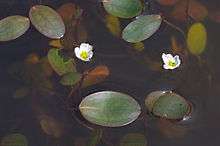Luronium
| Luronium | |
|---|---|
 | |
| Scientific classification | |
| Kingdom: | Plantae |
| (unranked): | Angiosperms |
| (unranked): | Monocots |
| Order: | Alismatales |
| Family: | Alismataceae |
| Genus: | Luronium Raf. |
| Species: | L. natans |
| Binomial name | |
| Luronium natans (L.) Raf. | |
| Synonyms | |
| |
Luronium natans is a species of aquatic plant commonly known as the floating water-plantain. It is the only recognized species in the genus Luronium, native to much of Europe, from Spain to Britain to Norway east to Ukraine.[1][2]
Description
Stems elongated, rising in the water or creeping and rooting at the nodes. Submerged leaves (if present) basal, linear; floating or aerial leaves elliptical to ovate. Flowers hermaphrodite, long-pedunculate in the axils of the floating or aerial leaves. Stamens 6. Carpels 6–15 in an irregular whorl, free, each with 1 ovule; styles apical. Fruitlets achenial, longitudinally many-ribbed, with a short apical beak. 2n = 42.[2][3][4][5]
Ecology
Acid ponds or canals. Declining.
In 2009 it featured on a first class Royal Mail stamp in the series "Endangered Plants".[6] It is said to have "spread eastwards from its core natural habitats in the lakes of Snowdonia and mid Wales in the 19th century, taking advantage of the canal network. In recent decades, however, pollution and recreational boating have led to its disappearance from many lowland waterways".[7]
Conservation
Within Europe, floating water-plantain is listed under Annexes II and IV of the Habitats Directive and Appendix I of the Bern Convention. Within Britain it is on Schedule 4 of the Conservation (Natural Habitats, etc.) Regulations 1994; Schedule 8 of the Wildlife and Countryside Act, 1981, and on the IUCN Red List it is classified as 'Least Concern'(LC).[8]
References
- ↑ Kew World Checklist of Selected Plant Families
- 1 2 Altervista Flora Italiana, Mestolaccia natante, Floating Water Plantain
- ↑ Rafinesque, Constantine Samuel. 1840. Autikon Botanikon 63.
- ↑ Joint Nature Conservancy Committee, 1831 Floating water-plantain, Luronium natans
- ↑ Luronium natans, National Museum of Wales
- ↑ Endangered Species Stamps
- ↑ Arkive, Floating water-plantain /
- ↑ Arkive, Floating water-plantain (Luronium natans)/
External links
- IUCN Red List of Threatened Species
- Tela Botanica, Alisma nageante
- Inventaire Nationale du Patrimonie Naturel
- Umwelt Sachsen, Schwimmendes Froschkraut (Luronium natans)